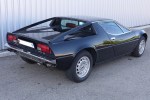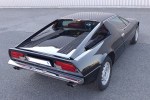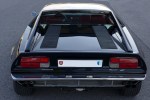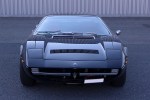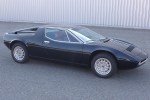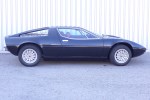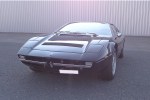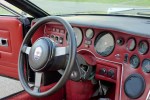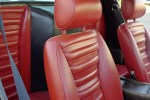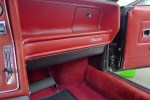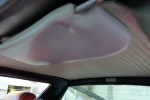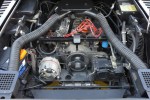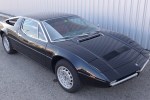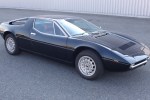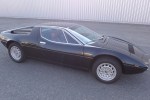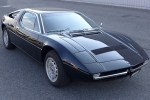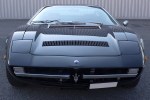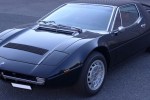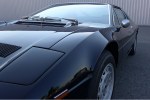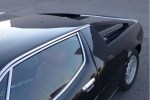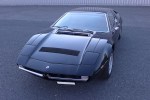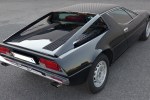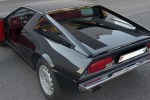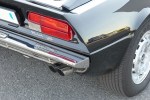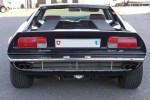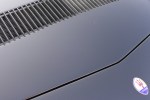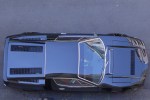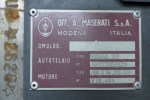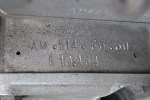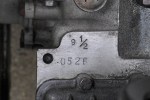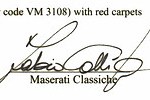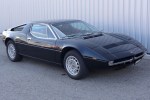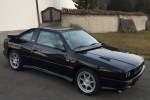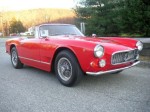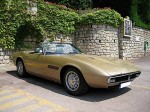Maserati Merak 3000 SS
- 1981
- 38.000 km
- AM122.A.US.2826
- CH, EU, US title
- CH, EU, US taxes paid
- Sold
This highly desirable 3.0-litre Merak SS is a very original survivor example with only 38.000 km on the odo-meter. Produced as a North American market model, chassis number 2826 rolled out of the factory gates in October 1981 and was first registered in June 1982.
Later in its life the car found its way to Holland, before it was sold in 2007 to the current owner, who brought the car to Switzerland to add to his collection. Having always wanted a Merak, he immediately knew that this matching-numbers example was a long-term car, and commissioned several marque specialists in order to preserve the cars excellent original condition.
The factory correct Nero Profondo painted body over Rosso interior retains a remarkable finish and luster. Body and chassis are clean except for some minor damage to the nose cone. The very attractive Bora style interior with special customer ordered carpets is very clean with working gauges, switches as well as the original radio.
The car is in excellent working condition, ready to be driven and enjoyed or included as an addition to any sports car collection, and is the embodiment of all the best traits of Maserati engineering.
This Merak is easy to register in Switzerland, the US and the EU. Please also note that the car has already been subject to Swiss and European Union taxes.
Accompanying documentation consists of the Maserati Classiche certificate, many service receipts as well as the former Dutch RDW registration document. The car comes with a Swiss Carte Grise registration document, along with a new Controle Technique (MoT certificate) and Emission Control certificat.
The complete original tool kit, owner's manual and parts catalog are also included in the sale.
When, towards the end of the 60s, Citroën, then major shareholder of Maserati, decided that the moment was bright for the Casa del Tridente to launch a mid-engined GT, it already had in mind two distinct models, one a luxury version in the traditional mode and another cheaper version to compete with the likes of the Lamborghini Urraco and the Ferrari 308 GT4.
The Maserati Bora had been launched in 1971 and represented the typical Maserati GT concept, with its big classic 4.7-litre V8 and the beautiful line sculptured by Giorgetto Giugiaro. A year later, in 1972, Maserati introduced what could be considered a Bora Junior: the Merak, not named after a wind this time but after a star from the constellation Ursa Major.
The Merak utilised a great part of the structure of the chassis of the Bora and the body design was placed once more in the hands of Giugiaro who cleverly maintained the Bora's overall shape; but the new car was powered by a 3-litre V6 directly derived from the Maserati engine already in use in the Citroën SM.
Consequently the price of the Merak was substantially lower than that of the prestigious Bora; the new model being aimed at a potentially larger market. For Citroën and Maserati this made practical sense, as at the time there was a move towards producing lower capacity high performance cars with lower fuel consumption, and here was yet another opportunity for the inclusion of more Citroën components.
The Merak adopted a major part of its chassis and bodywork from the Bora, especially in the frontal area. The main differences between the Merak and the Bora were at the rear, both visually and mechanically: a longitudinally mounted 3-litre V6 was installed.
Maserati manufactured this V6, derived from an abandoned V8 engine design from Giulio Alfieri back in 1965, in a 2.6-litre version for the Citroën SM. The capacity of the V6 engine rose from the SM's 2675cc to 2965cc by increasing the bore size from 87 mm to 91.6 mm and the engine now developed 190 hp with a declared top speed of around 240 km/h.
In order to reduce costs, the tubular chassis of the Bora, with its costly rear sub frame, was replaced by an all-steel monocoque with a more simplified rear sub frame due to the smaller lighter V6 engine.
The body of the Merak designed by Giugiaro is practically identical to the Bora from the nose to the doors. The only differences being to the front panels reduced to accommodate the shape of the bumper, the chrome-trimmed grilles being replaced by a chromium plated bumpers either side of the traditional trident. The Bora's distinctive protective rubber strip along the belt-line was replaced with a single character line. The single retractable headlights remained unchanged.
For the rear Giugiaro gave the Merak a more standard treatment, with a flat engine bonnet incorporating louvered slats to expel warm air from the engine bay behind a flat full width rear window. To soften the chopped-roof, Giugiaro added two buttresses running from the roofline to the rear of the car to give a more elegant profile. These buttresses were removable to facilitate engine maintenance.
Although the Merak was less expensive than the elite Bora, Maserati tradition demanded that the car had to be stylish, solidly built, fast, reliable and comfortable.
The Merak, designated Tipo 122 by the factory, was officially launched at the Paris Motor Show in October 1972. The lighter and more powerful Merak SS was introduced at the Geneva Motor Show in March 1975 and the Merak 2000 GT was first displayed at the Turin Motor Show in November 1976.
Suspension was independent all round with unequal length wishbones/A-arms, coil springs, hydraulic shock absorbers with anti-roll bar at the front and rear. Braking was by Citroën's high-pressure hydraulically assisted system with ventilated discs all round. In 1976 Maserati opted for a vacuum-assisted braking system.
In 1976 Maserati replaced all Citroën components. Having ended its partnership with Citroën, it was De Tomaso who decided to introduce a 2-litre version, for the Italian market. And so was born the Merak 2000 GT, its 2-litre engine producing approximately 170 hp and a top speed of around 220 km/h.
The Merak like the Bora, was in all its versions, a sports car that was comfortable and easy to drive: the controls were very docile and for a GT of this type it had good all-round visibility; the engine was very responsive but never brutal and its road-holding and handling were excellent. Later Meraks also benifitted from a traditional servo-assisted braking system instead of the high pressure Citroën system fitted to the earlier 3-litre models which had a tendency to lock the wheels under heavy braking.
Naturally the modifications made to the Merak were not just to the engine and mechanics. In fact the first 3-litre models were fitted with the same dashboard and single-spoked steering wheel as the Citroën SM. The Citroën fascia panel was soon replaced with a more standard square shaped instrument panel, designed by Maserati, with a classic four-spoked steering wheel. Later models were fitted with the same dashboard as the Bora.
The bucket seats, facia, door trim, center console and rear bulkhead were trimmed in leather. The dashboard incorporated analogue instruments including a speedometer, rev counter, oil temperature, water temperature and fuel level gauge, battery condition indicator and a clock. The center console housed the electric window switches, cooling and heating/ air conditioning controls and air vents.
The 2000 GT, was fitted with the grilles on the front cowling, but without the front spoiler, which was available as an option. Other details that distinguished it from the Merak and Merak SS models: a wide black adhesive strip which ran along the length of the car just below the belt-line, black front and rear bumpers in place of the usual chrome, and the same squared dashboard of the later 3-litre versions, with a four-spoked steering wheel, but with Citroën derived oval shaped instruments instead of the round ones.
In its production run from 1972 to 1983 factory records show that 1817 Meraks were built, 970 were Merak SSs and 200 were 2000 GTs; the most productive year being 1973.
The Merak SS model is also split into three different types, each type has its own number of cars produced. 592 Oval instruments, including square dashboard, 312 with Bora dashboard as well as USA conversions and 66 Tipo 80.
The Merak, like the Bora, suffered greatly at first from the fall-out of the energy crisis, and above all later from the managerial difficulties at Maserati since the Casa del Tridente was making the difficult transition from the old owners Citroën to that of new owner, Alejandro De Tomaso.
“ your classic auto specialist; world-wide collector car expertise ”
We buy, sell, broker, locate, consign and appraise exceptional classic, sports and collector automobiles, arrange transport, customs formalities and registration.
Jaguar, Ferrari and Maserati expertise, though our collection includes a wide variety of other superior antique, vintage, prewar and race cars.
Contact us when you are serious about owning or selling a fine classic motor car or motorcycle. Geneva, Switzerland-based, we serve clients world-wide.
Chemin des Tulipiers | 1208 | Geneva | Switzerland | +41 (0) 787.055.745
